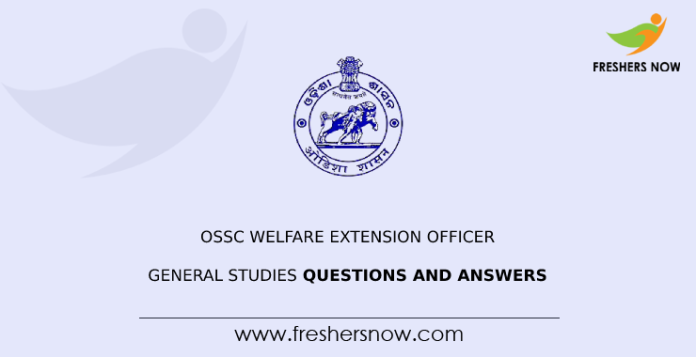
OSSC Welfare Extension Officer General Studies Questions and Answers: Curious to know about what questions will be covered in the OSSC Welfare Extension Officer General Studies. well then, take a look at this article that can give you a brief idea about which topics and types of questions will be asked in the OSSC Welfare Extension Officer General Studies Test.
OSSC Welfare Extension Officer General Studies Questions and Answers
OSSC Welfare Extension Officer General Studies quiz that is provided here will enable you to learn about what topics you need to cover at the time of your preparation and where you need to concentrate more to do well in the exam. So make sure you answer the OSSC WEO Quiz for General Studies and at last check your score.
1. The Mauryan ruler who used the name ‘Piyadasi’ in his official declarations was
a. Bimbisara
b. Ashoka
c. Chandragupta Maurya
d. Brihaddrata
Answer: b. Ashoka.
2. In which script were the Ashoka’s inscriptions written?
a. Dev Nagari
b. Persian
c. Sanskrit
d. Brahmi
Answer: d. Brahmi Script.
3. Which literary source describes how Chandragupta Maurya get Chanakya’s assistance to overthrow the Nandas?
a. Mudra Rakshasa
b. Indica
c. Arthasastra
d. Divyavadana
Answer: a. Mudra Rakshasa.
4. Which of the following edicts describes Emperor Ashoka’s visit to the birthplace of Lord Buddha?
a. Maski
b. Sannati
c. Rudramma
d. Shanti
Answer: c. Rudramma
5. Which inscription tells about the Kalinga war?
a. Rock edict 13th
b. Rock Edict 12th
c. Rummindei
d. Girnar
Answer: b. Rock edict 13th.
6. Which of the following kings convened the fourth Buddhist Council in Kashmir?
a. Chandragupta Maurya
b. Bimbisara
c. Kanishka
d. Ajatashatru
Answer: c. Kanishka.
7. Who among the following is the poet who composed ‘Buddhacharita’, a biography of Buddha?
a. Ashvaghosh
b. Bhavabhuti
c. Vasumitra
d. Nagarjuna
Answer:a. Ashvaghosh.
8. The great Mauryan Emperor Ashoka patronized which sect of Buddhism?
a. Mahayana
b. Hinayana
c. Vajrayana
d. Tantric Buddhism
Answe: b. Hinayana.
9. At which place did Lord Buddha gave his first sermon?
a. Kashi
b. Vaishali
c. Sarnath
d. Magadh
Answer: c. Sarnath.
10. Who among the following was Buddha’s foster mother?
a.Purna
b. Gajalakshmi
c. Maya
d. Mahapajapati Gotami
Answer: d. Mahapajapati Gotami.
11. Lord Buddha’s real name was?
a. Vardhman
b. Siddharth
c. Mahavir
d. Priyadarshan
Answer: b. Siddharth.
12. Gautama Buddha was born in:
a. Gaya
b. Lumbini
c. Kapilvastu
d. Sarnath
Answer: b. Lumbini.
13. Where is the famous Mahabodhi Temple located?
a. Kushinagar
b. Lumbini
c. Bodh Gaya
d. Sarnath
Answer: c. Bodh Gaya
14. Where did Gautama Buddha attain Enlightenment?
a. Lumbini
b. Sarnath
c. Kusinagar
d. Bodh Gaya
Answer: d. Bodh Gaya.
15. In which state of India is the famous Sanchi Stupa located?
a. Andhra Pradesh
b. Maharashtra
c. Madhya Pradesh
d. Jharkhand
Answer: c. Madhya Pradesh.
16. What is the name of the Ocean in sea?
a. Indian Ocean
b. Atlantic Ocean
c. Pacific Ocean
d. Arctic Ocean
Answer: c. Pacific Ocean
Explanation: The Pacific Ocean is the largest ocean in the world. It covers more than 60 million square miles and is home to countless species of marine life.
17. Which of the following is the largest mammal in the world?
a. Giraffe
b. Elephant
c. Blue Whale
d. Hippopotamus
Answer: c. Blue Whale
Explanation: The blue whale is the largest mammal in the world, growing up to 100 feet long and weighing up to 200 tons.
18. What is the smallest continent in the world?
a. Europe
b. Asia
c. Australia
d. Africa
Answer: c. Australia
Explanation: Australia is the smallest continent in the world. It is also the only continent that is also a country.
19. Which of the following is not a primary color?
a. Red
b. Blue
c. Green
d. Orange
Answer: d. Orange
Explanation: The primary colors are red, blue, and green. They are the colors that cannot be created by mixing other colors together.
20. Which of the following is a type of cloud?
a. Nimbus
b. Stratus
c. Cirrus
d. All of the above
Answer: d. All of the above
Explanation: Nimbus, Stratus, and Cirrus are all types of clouds. Nimbus clouds are associated with rain, Stratus clouds are low and flat, and Cirrus clouds are high and wispy.



